 In this article, we're going to look at the 18th-century hair and makeup. This period is known for its artificialness in fashion and lifestyle. Until the very end of the century, natural shapes, silhouettes, and features were out of fashion. The aristocrats preferred several meters high wigs and hairdos, false teeth pulled out of corpse’s mouth, and fake eyebrows made from mouse skin. So, romantic 18th-century fashion trends are not that romantic at all actually. But let’s see the advantages and drawbacks of this era’s lifestyle.
In this article, we're going to look at the 18th-century hair and makeup. This period is known for its artificialness in fashion and lifestyle. Until the very end of the century, natural shapes, silhouettes, and features were out of fashion. The aristocrats preferred several meters high wigs and hairdos, false teeth pulled out of corpse’s mouth, and fake eyebrows made from mouse skin. So, romantic 18th-century fashion trends are not that romantic at all actually. But let’s see the advantages and drawbacks of this era’s lifestyle.
The article is based on a video by Amanda Hallay, fashion historian
Look at this guy here. No, he is not wearing some weird serial killer mask. What he is holding up to his face is a powder cone. Fashionable people would hold one of these creepy-looking cones up to their faces when their hair was being powdered so that the powder wouldn't get into their eyes or ruin the rest of that makeup. This was the Golden Age of powdering.
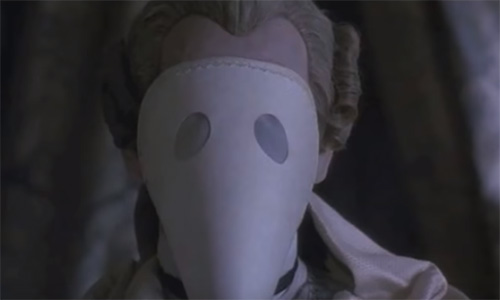
Powder was either applied with a sort of a flicky brush or with a mechanical pump (far more efficient). What was it made of? At the lower end of the spectrum, it was made out of things like cornstarch, but the real fashionistas used very finely milled and scented flour. Powder would sometimes be tinted as well – tinted blue or violet or purple, just to shake things up a bit.
Male hats, hair, and wigs
Wigs at the beginning of the 18th century were very similar to the full bottom wigs from the end of the 17th century. They had these two large peaks at the top, and such wigs are called “allonge wigs”.
But then, very quickly appeared another type of wigs called “buckled wigs” or “buckled clubbed wigs”.
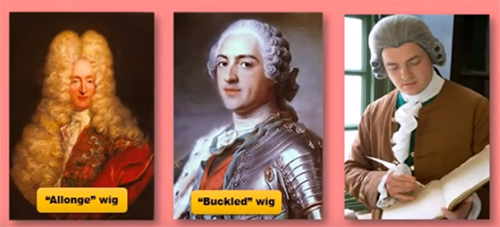
Wigs were not white, they were not made of white hair, as some people may believe. They were usually brown and then powdered white.
Some men, however, couldn't be bothered with all of this and they just grew their natural hair out to their shoulders and then tied it in a ponytail at the back. Working-class men particularly. And colonial American men.
The ponytail on both a buckled wig and on natural hair also has a name, it was called a “queue”.
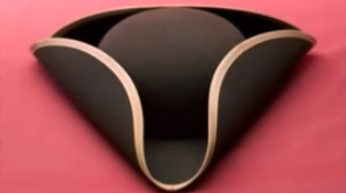
The hat of the entire 18th century was a tricorn hat. Interestingly, it wasn't called a tricorn hat until about 100 years after people wore it. It got the name in the 19th century. During the 18th century, it was simply called a “cocked hat”.
Female hats, hair, and wigs
Contrary to popular belief, 18th-century women seldom wore full wigs. Instead, fashionable women would coif their natural hair and then add hairpieces and fake curls and lots of false hair to give height for high-fashion events and to sport the “novelty coifs” of the era. Their hair would be powdered white, but occasionally, also it would be tinted with those blues or purples.
In the picture on the left, there is a pretty good and very accurate reconstruction of what everyday hair was like for the fashionable women of the 18th century. And on the right, you can see a hairdo for special occasions. Her natural hair is teased and pulled over fake hair to give that enormous beehive, with fake rolls, probably, added at the side and flowers and feathers and this and that.
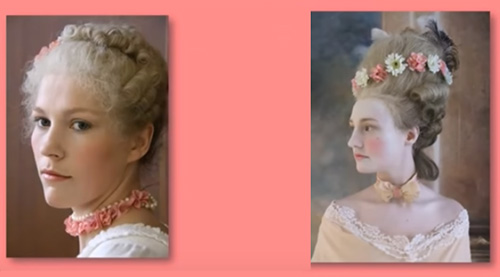
But sometimes, these coiffures would become incredibly high and spectacular, kind of ridiculous.
But none was as silly as the Belle-Poule, debuted by Mary Antoinette herself. The Belle-Poule was the name of a French military ship that was being honored in this hairdo, an incredibly high, powdered hairdo with a model ship incorporated at the top.
No wonder satirist made fun of these hairdos and hats.
And they went along with novelty hats. Hats were either big figuratively or big literally. Figuratively, the novelty hat that incorporated everything – bows and flowers and ostrich feathers, was extremely popular. The hats had to be big because the hairdos were so big.
The hat on the left was extremely popular in the 18th century, in the summer. It's called a “bergere”. And bergere is “shepherdess”. Marie Antoinette used to dress up as a shepherdess, along with her friends, because she had an entire little farm village constructed in the grounds of Versailles, so she and her friends could pretend they were poor.
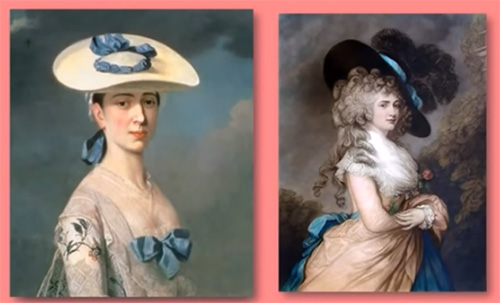
These hairdos in the 18th century got so enormous that on a windy or rainy day, you would need something to protect them. And the “caleches” protected your hair.
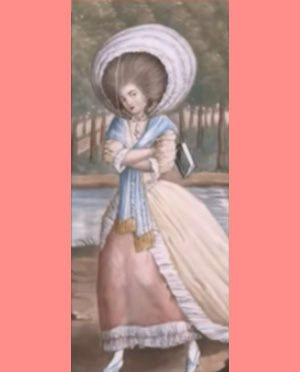
Women’s shoes
Let's look at shoes. Lady's shoes of the 18th century were every bit as ornate and over-the-top as their dresses. With lace and embroidery and gold and brocade and heels.

Fun fact: in the 18th century, shoes did not come in left and right. Each was identical, and the shoe then took the form of each foot after a person wore it for a few times.
Many of these shoes had very interesting novelty heels.
Mules were also very popular.
Men’s shoes
But as we mentioned earlier, men's shoes were weirdly sensible by comparison. Brown or black leather, with a buckle. Although sometimes, even men's shoes could get a bit extreme.
Makeup
What we have here is actually very similar to what makeup in the 18th century actually looked like.
Lead-based ceruse covered the face of both men and women, but women would often use it on their necks, shoulders, and decolletage as well. Women would also highlight the veins of their breasts in blue.
Rouge was made of something called Spanish Wool, which was a rough, dye-soaked textile that people would rub onto their cheeks in triangular shapes. It was a bit like a scouring pad.
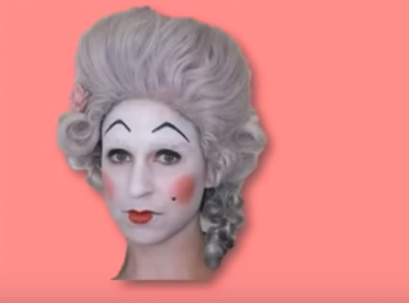
Lipstick was applied to the very front of the lips in a “bee sting” look that would come back in the 1920s.
And eyebrows were high, and either drawn on with pencil or stuck on with fake eyebrows made of… mouse skin.
Mouches (French for “fly”, an insect) were little patches, often used to cover scars from pox or syphilis, but then they became a little trend in their own right. Mouches were made of leather or velvet or satin or silk. Sometimes, they were in a variety of novelty shapes – hearts or stars or even in the shape of a horse and carriage.
This is really what people looked like in the 18th century.
Horrific realities of the 18th century
Powdered wigs and hairpieces were styled using beeswax or lard, and as a consequence, they absolutely stank. So people doused their hair and bodies with perfume to cover up the smell. But worse… They were infected with lice and fleas. So even the most fashionable of aristos would carry pretty little “scratching sticks” around with them to scratch the flea bites on their head.
Further, it gets so much worse. These pretty powdered faces might look good in paintings, but in real life, the pasty ceruse and rouge could look completely grotesque. But it often masked a bigger issue: smallpox was rampant in the 18th century, and people used thick coats of ceruse to cover the permanent scarring of smallpox.

The nobility of Europe consumed vast amounts of sugar, and in a time of poor to non-existent dentistry and dental hygiene, many of these “pretty people” had rotting teeth, missing teeth, diseased gums, and perpetually foul breath. Many people wore false teeth. And guess what they were made of? – Real teeth. Poor people would have their own teeth removed and sell them to denture makers, who would make dentures and sell them to the aristocracy. Or people would pull teeth from the mouths of dead people. More expensive ivory teeth could be also used.
Another horrible disease widespread in the 18th century was syphilis. It was common in the upper classes and depending on the severity, it could have terrible outward physical consequences, the least of which were the huge pus-filled boils that covered the body.
The syphilis bacteria also ate away at the face, starting with the eyes. So it was not that uncommon to see people in the 18th century sporting glass eyes, which, given the technology available, were not all that convincing. Also, there was a market in the 18th century for false noses that syphilis sufferers could wear, because syphilis could actually eat your nose away. Fake noses were often attached to glasses (kind of like the joke glass&noses we have today).
Here is a contemporaneous image “Six Stages of Mending a Face”. You put your wig on, put your false eye in, not sure what's happening in image 3, then put your makeup on, and put false teeth in. This was a reality for many people.
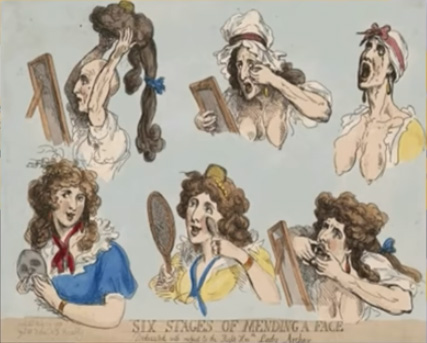
Of course, there were many perfectly normal and attractive aristocrats in the 18th century, too. Just don’t take the 18th century as that beautiful, romanticized era that we see on TV.
(c)



I got the permission from the author of this video to use it and gave her name and active link)